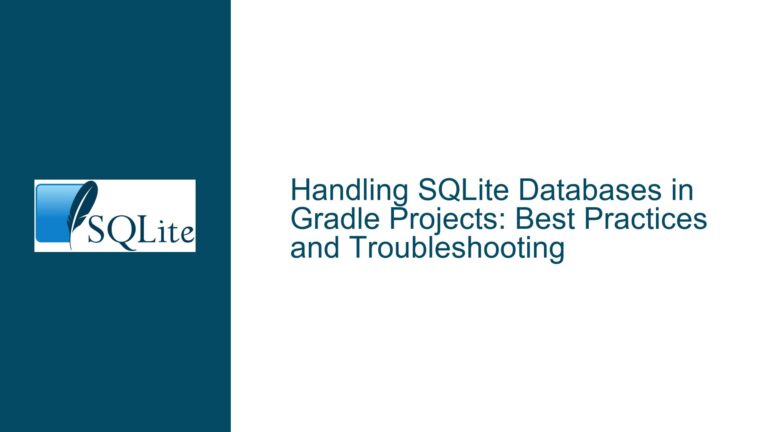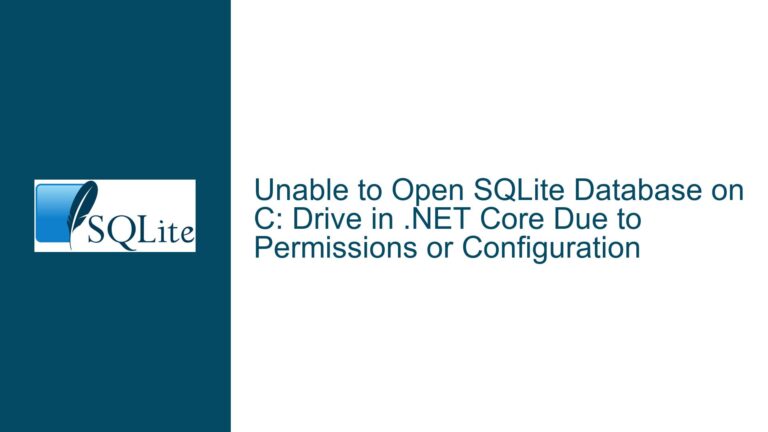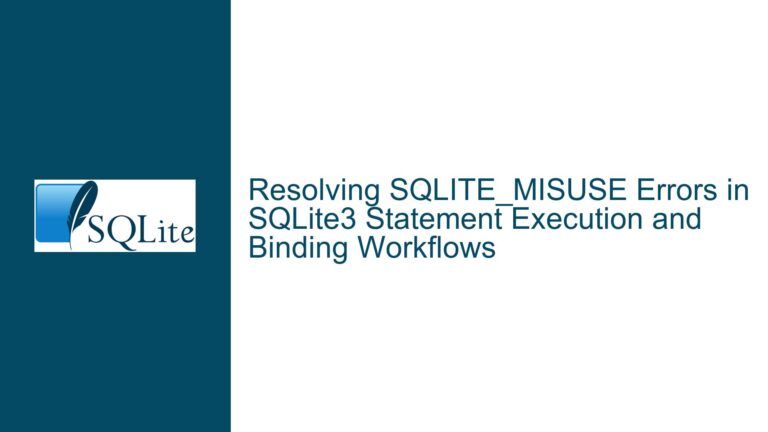Prepared Statements on Temp Database Block Main Database WAL Mode Changes
WAL Mode Transition Failures Due to Active Temp Database Prepared Statements
When attempting to switch the main database between WAL (Write-Ahead Logging) and other journal modes, SQLite may block the operation if there is an active prepared statement associated with the temp database. This occurs even when the prepared statement is as simple as a SELECT query on a temporary table. The error manifests as an inability to execute PRAGMA journal_mode=WAL or PRAGMA journal_mode=DELETE on the main database, often returning SQLITE_BUSY or silently failing to apply the change. The root cause lies in SQLite’s transaction and locking model, where active statements on one database can implicitly restrict operations on another attached database. This behavior is particularly counterintuitive when working with temporary tables, as developers often assume the temp database operates in isolation.
The conflict arises because SQLite manages locks at the connection level, not per database. When a prepared statement is active on the temp database, it holds a read lock on the entire connection. Switching the main database to WAL mode requires an exclusive write lock to modify the database schema, which cannot be acquired while any read locks are active. This includes locks held by seemingly unrelated operations on the temp database. The issue is exacerbated when applications interleave operations across multiple databases within the same connection, such as reading configuration data from a temporary table and applying pragmas to the main database in a single pass. Developers may misinterpret the error as a bug or limitation in SQLite, but it is a deliberate design choice to enforce transactional consistency.
Lock Contention and Cross-Database Transaction Isolation
The inability to switch journal modes stems from three interrelated factors:
Transaction Scope Across Attached Databases:
SQLite treats all attached databases (main, temp, and others) as part of a single transactional unit. A prepared statement on any attached database places the entire connection in an implicit transaction. For example, aSELECTon a temporary table initiates a read transaction that spans the connection, preventing schema modifications like WAL mode changes on the main database until the statement is finalized or reset.Prepared Statements and Implicit Locks:
Prepared statements retain locks based on their state:sqlite3_prepare_v2(): No locks held.sqlite3_step(): Acquires a read lock after returning the first row.sqlite3_reset(): Releases locks but keeps the statement reusable.sqlite3_finalize(): Releases all locks and resources.
An active statement (post-sqlite3_step()) on the temp database holds a read lock, blocking the exclusive lock required for WAL mode transitions on the main database.
Pragma Execution and Transaction Boundaries:
PRAGMA journal_mode=WALis not a simple configuration change—it rewrites the database header and requires a schema write lock. If the connection has an open transaction (even a read transaction), SQLite cannot grant the exclusive lock needed for this operation. This is true even if the transaction originated from a different database attached to the same connection.
A common pitfall occurs when applications store pragma commands in a temporary table, iterate over them using a prepared statement, and execute each pragma immediately. The active cursor reading from the temporary table blocks the pragma targeting the main database, creating a deadlock-like scenario. Developers may incorrectly assume the temp database’s in-memory nature exempts it from locking rules, but its integration into the connection’s transaction model means it participates in lock contention.
Mitigating Lock Conflicts via Statement Lifecycle Management and Connection Isolation
Step 1: Finalize or Reset Temp Database Prepared Statements Before Pragma Execution
If a temporary table stores pragma commands for the main database, avoid executing them while iterating over the table. Instead:
- Use
sqlite3_step()to retrieve all rows from the temp table and store the pragma texts in an application-side buffer. - Call
sqlite3_reset()orsqlite3_finalize()on the prepared statement to release the read lock. - Execute the accumulated pragma commands in a separate pass.
Example:
// Read pragma commands from temp table
sqlite3_stmt *stmt;
const char *sql = "SELECT pragma_text FROM temp.pragma_commands";
sqlite3_prepare_v2(db, sql, -1, &stmt, NULL);
std::vector<std::string> pragmas;
while (sqlite3_step(stmt) == SQLITE_ROW) {
pragmas.push_back((const char*)sqlite3_column_text(stmt, 0));
}
sqlite3_finalize(stmt); // Releases read lock
// Apply pragmas to main database
for (const auto &pragma : pragmas) {
sqlite3_exec(db, pragma.c_str(), NULL, NULL, NULL);
}
This ensures no active statements block schema changes on the main database.
Step 2: Isolate Temp and Main Database Operations via Separate Connections
For applications that heavily use temporary tables alongside WAL mode, create two distinct SQLite connections:
- Connection A: Handles temporary tables and transient data.
- Connection B: Manages the main database, including journal mode changes.
This separation eliminates cross-database lock contention because transactions and locks are local to each connection. For example:
sqlite3 *db_temp, *db_main;
sqlite3_open(":memory:", &db_temp); // Temp database
sqlite3_open("main.db", &db_main); // Main database
// Use db_temp for preparing statements on temporary tables
sqlite3_exec(db_temp, "CREATE TEMP TABLE pragma_commands(pragma_text TEXT)", NULL, NULL, NULL);
// Use db_main for pragma operations
sqlite3_exec(db_main, "PRAGMA journal_mode=WAL", NULL, NULL, NULL);
Note that temporary tables are connection-specific, so db_temp will not interfere with db_main’s locks.
Step 3: Batch Pragma Operations and Avoid Interleaved Execution
If using a single connection is mandatory, structure code to avoid interleaving temp database reads with main database writes:
- Complete all read operations on the temp database and finalize/reset their statements.
- Group all pragma commands into a single transaction to minimize lock escalation overhead.
For instance, instead of:
-- Anti-pattern: Mixing temp reads and main writes
BEGIN;
INSERT INTO temp.config VALUES ('journal_mode=WAL');
SELECT pragma_text FROM temp.config; -- Active statement blocks next pragma
PRAGMA journal_mode=WAL; -- Fails due to active read from temp.config
COMMIT;
Use:
BEGIN;
INSERT INTO temp.config VALUES ('journal_mode=WAL');
COMMIT; -- Finalize INSERT first
-- Now execute pragmas after finalizing temp reads
PRAGMA journal_mode=WAL;
Step 4: Explicit Transaction Control for Schema Changes
SQLite’s auto-commit mode can obscure transaction boundaries. Use BEGIN EXCLUSIVE and COMMIT to explicitly control when schema modifications occur:
sqlite3_exec(db, "BEGIN EXCLUSIVE", NULL, NULL, NULL);
sqlite3_exec(db, "PRAGMA journal_mode=WAL", NULL, NULL, NULL);
sqlite3_exec(db, "COMMIT", NULL, NULL, NULL);
This forces the schema change to occur in a dedicated transaction, reducing the window for lock conflicts.
Step 5: Monitor Open Statements with sqlite3_next_stmt()
Debug lingering prepared statements using:
sqlite3_stmt *stmt = NULL;
while ((stmt = sqlite3_next_stmt(db, stmt)) != NULL) {
if (sqlite3_stmt_busy(stmt)) {
// Handle active statement
}
}
This helps identify unprepared statements that may be blocking WAL transitions.
By adhering to these practices, developers can resolve WAL mode transition failures caused by temp database prepared statements while maintaining the integrity of multi-database workflows.






